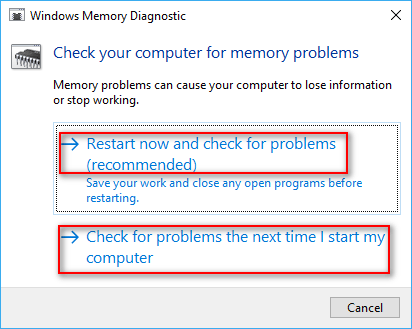Windows 10 brings a variety of error notifications and stop codes whenever any function or feature refuses to run properly. One of its error codes is Blue Screen of Death (BSOD) and when you find this code on your screen, use the Windows 10 stop code to figure out and resolve the issue on your desktop. A stop code appears on the screen to alert you about a specific error or to prompt you to fix the problems. The Windows 10 “Memory Management” stop code belongs to the latter.
The Memory Management manages your PC’s memory, tracks the memory location on your system, processes between the RAM & physical memory, and looks at the overall health. It also decides the allocation of the memory. As the Memory Management stops working, your screen will start showing you BSODs from time to time, and at times the Memory Management crashes down along with your system. Disk error, defective RAM and drivers, and hardware & software issues are the main reason behind the memory management BSOD. Fortunately, you can fix this error, and the first step is to restart your PC or update the operating system and then restart your PC.
If this doesn’t fix the issue, then use the methods given below:
The Windows 10 “Memory Management” stop code belongs to the latter. The Memory Management manages your PC’s memory, tracks the memory location on your system, processes between the RAM & physical memory, and looks at the overall health. Other methods that you can try in order to fix the Windows stop code MEMORYMANAGEMENT in Windows 10: Remove recently installed software and hardware. Increase Virtual Memory. Look for software problems like software corruption and conflict. Update your Windows 10 to the latest version. 3: Perform Windows Memory Diagnostic: Whenever you run into Windows 10 BSOD Stop Code memory management error, using the Memory Diagnostic utility is essential. We need to check if the system RAM is working fine or not. Whenever we reboot a system, this utility runs automatically in the background and look for errors. One of the most common causes of the memory management error in Windows 10 is outdated or broken graphics card drivers. This scenario makes sense, especially since the graphics card has memory too.
Use Windows Memory Diagnostic Tool
The Windows Memory Diagnostic Tool shows the errors in your system memory, and it saves the scan into a text file for further analysis. This tool runs after a system reboot. Follow these steps to run this on your system:
- In the Start menu search bar, type “Windows Memory Diagnostic” and select the suitable option.
- Before moving onto this step, make sure you have taken the backup of all the essential files and documents. Then, click on “Reboot immediately and run the utility.”
- Press Windows + X key together and from the power menu, select Event Viewer.
- From Event Viewer (Local), select Windows Logs. Click on System and from the right column, select Find.
- On the box appearing on your screen, type “MemoryDiagnostic” and click on Find Next.
This will display the diagnostic results at the bottom of the open window. Now, you can check and resolve the issues.
Run Mem Test86
The Mem Test86 is used to run an in-depth memory test on the system. You can boot the Mem Test86 with the help of a USB flash drive and allow it to check your system’s RAM. This procedure will take a long time to complete based on the RAM amount you have on your desktop. To use this method, follow the steps given below:
- Go to the MemTest86 download page and download the Image for Creating Bootable CD (in ISO format).
- Write the MemTest86 ISO in a USB flash drive.
- Then, burn the MemTest86 using any tool of your choice and shut down your PC.
- Reboot it again while pressing F10, F11, DEL, or ESC key for the Boot Selection menu.
- Select the bootable MemTest86 USB flash drive, and the memory test will start automatically.
These steps complete the procedure and for better results, run this method twice on your PC.
Update the Drivers

New software and hardware come with new drivers, and at times, the system doesn’t receive the message properly, which may result in faulty drivers. Although this issue occurs very rarely, it is safe to run an update. Follow these steps to resolve the issue:

- Press Windows + I key together and select Update & Security.
- Click on View Update History.
- In the Start menu search bar, type “Device Manager” and select a suitable match.
- Scroll down the list and check if there is an error.
If you don’t find anything, then it indicates that your system driver is not causing any issue. In case there is an issue, use a third-party tool to update all the drivers available in your system.
Microsoft Windows Stop Code Memory Management
Run CHKDSK
The CHKDSK Windows system tool will check the file system and fix the issues in the process, at the same time. Use the following step to run CHKDSK:

Windows Stop Code Memory_management Windows 10
- From the Start menu search bar, type Command Prompt, and use the best-suited result.
- Run as Administrator and type “chkdsk/r” command.
- Hit the Enter key, and the command will start scanning and resolving the errors on your PC.
It is quite tricky to resolve the Memory Management BSOD, but the methods mentioned above are most likely to fix the stop code on your desktop. If neither of these works, then resetting the system hardware and your PC from the Settings app will work for you.
